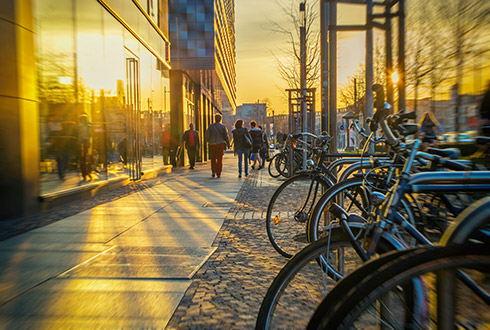Home » People and Settings » Community Living
Community Living
Community settings are very diverse. Restaurants, libraries, churches, and stores are part of the community. Social events and activities occur in community settings. City buildings where people go to vote and be part of town discussions are also part of the community. Each person is involved in the community in different ways. Young children, youth, and older adults have different roles and strengths that they can bring to a community. Sometimes people do not feel like they are part of their community. Living with a mental illness, developmental disability, autism, traumatic brain injury or other disability sometimes makes it more difficult to reach out to other people. People may feel lonely or sad because they do not know how to make friends with other people. Positive supports are used to show people how to get more involved in activities. Sometimes positive supports help people make new friends. Other positive supports encourage someone to reach out to other people at social events. Making a contribution to your community can increase feelings of wellbeing. Becoming a volunteer, working in a job, and voting are part of giving back to a community. Some positive supports are used to help all of the people living in a community setting. These types of positive supports are used to improve everyone’s social and emotional health.



Stories Across the Lifespan
The following stories describe how positive supports can be used in diverse community living settings.
- Trauma Informed Approaches and Community Living: Impact Feature Issue on Violence Against Women with Developmental or Other Disabilities (external web page)
- ABA and Community Living: Roberto, Don, and Paul (MNPSP web page)
- Assertive Community Treatment: Jose (MNPSP web page)
- Assertive Community Treatment: Melissa (MNPSP web page)
- Person-Centered Practices and Community Living: Katie and Cliff (MNPSP web page)
Community Living Resources
- Building Healthy Communities (external web page)
- Video: 8 Dimensions Short Video (external web page)
- Wellness Self-Management Workbook (pdf)
- Mental Wellness for People with Intellectual or Developmental Disabilities (pdf)
- Promoting Wellness (external web page)
- Minnesota Adult Mental Health Assertive Community Treatment Information (external web page)
- Dartmouth Assertive Community Treatment Scale (DACTS) (pdf)
- MN Department of Human Services Online Mental Health Policy Manual (external web page)
- National Alliance on Mental Illness Minnesota –Fact Sheets on ACT (external web page)
- Beach Center: Operation Positive Change: PBS in an urban Context (external web page)
- Association for Positive Behavior Support Home and Community Network (external web page)
- Assertive Community Treatment Implementation Manual—The Evidence-based Treatment Guide from The Center for Evidence-based Practices and Its Ohio Assertive Community Treatment Coordinating Center of Excellence (pdf)
- Impact: Sexuality Feature Issue on Sexuality and People with Intellectual, Developmental and Other Disabilities (external web page)
- Impact Newsletter: Feature Issue on Parenting Teens and Young Adults with Disabilities (external web page)
- Cost Effectiveness of Assertive Community Treatment (pdf)
Positive Support Strategies for Community Living
Below are some articles designed to provide important background information about topics that are relevant across lifespans and settings.
- Applied Behavior Analysis in Practice – ABA is focused on better understanding how different variables impact an individual’s behavior.
- Assertive Community Treatment History – A group of mental health professionals reviewed the mental health system to determine strategies to help people remain in their communities.
- Person-Centered Planning and Promoting Quality of Life – One way to think about person-centered practices from a systems perspective is to use a Three-Tiered Model of Positive Supports.
- PBS and Preventing Problem Behavior Using the Three-Tiered System – Considering larger organizational issues can be a helpful way to create a positive climate and prevent challenging behavior.
- Positive Behavior Support and Individualized Planning – The first step in an individualized positive behavior support process at Tier 3 is to set up a person-centered plan.
- Trauma Informed Approaches and Three-Tiered Systems of Positive Support – Trauma informed care approaches are implemented across education and human service organizations.
- Relationship Between Applied Behavior Analysis and Positive Behavior Support – Understand the history and current relationship between Applied Behavior Analysis and Positive Behavior Support

